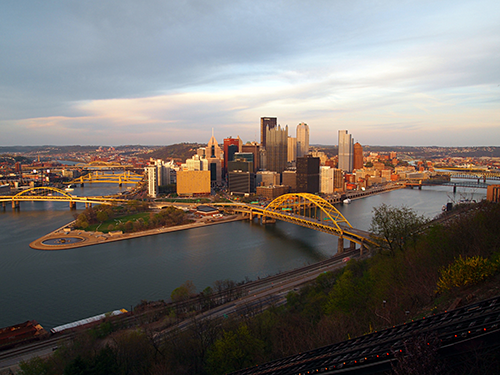Oct 30 2015 At the intersection of placemaking and collaboration: examples from Pittsburgh and New York City
 With the release of our report on Boston’s Innovation District earlier this month, we’ve been exploring lessons for public sector officials working with business and non-profit partners to create innovative economic development strategies that would be difficult to achieve on their own. One illuminating perspective came from Ethan Kent, Senior Vice President of Project for Public Spaces: “Focusing on place can work to break down silos among sectors and within government and professional fields. And when we start to break down these silos, when we start to lead with people and place, it quickly becomes clear that place attachment translates to economic and social capital — and it’s what will ultimately make our cities more innovative, distinctive, and competitive.”
With the release of our report on Boston’s Innovation District earlier this month, we’ve been exploring lessons for public sector officials working with business and non-profit partners to create innovative economic development strategies that would be difficult to achieve on their own. One illuminating perspective came from Ethan Kent, Senior Vice President of Project for Public Spaces: “Focusing on place can work to break down silos among sectors and within government and professional fields. And when we start to break down these silos, when we start to lead with people and place, it quickly becomes clear that place attachment translates to economic and social capital — and it’s what will ultimately make our cities more innovative, distinctive, and competitive.”
There are several initiatives in cities across the United States that rely on this intersection of placemaking, collaboration, and economic development. In March, Pittsburgh Mayor Bill Peduto announced the creation of Envision Downtown, a cross-sector partnership between the Mayor’s Office and the Pittsburgh Downtown Partnership (PDP) with a focus on placemaking and street improvement projects to accelerate economic growth. One key effort is to transform Pittsburgh’s downtown area by creating “complete streets” — redesigning the urban infrastructure so it accommodates cars, pedestrians, bicyclists, and public transit riders. “Investing in smart, multimodal transportation infrastructure is among the greatest needs facing Pittsburgh and will not only support economic growth, but the health and safety of everyone in the city,” explained Mayor Peduto in a news release.
The success of Envision Downtown relies on the support of diverse stakeholders from across sectors and from the community. Key partner PDP, for example, is composed of businesses, civic organizations, foundations, and residents, and Envision Downtown’s Advisory Committee “represents the diversity of Pittsburgh as a whole and the broad group of stakeholders who live, work, and visit downtown Pittsbugh.” The initiative is committed to involving not only individuals from the government, non-profit, and business sectors who have a professional stake in improving the downtown area, but also members of the community who are personally invested in their city. The Public Space Public Life Survey, their newest project that is being implemented with the help of architecture firm Gehl Studios, will recruit volunteers from the community to collect information that will illuminate how residents currently use public space and identify areas that need improvement.
In the case of a streetscaping program in the Crotona East neighborhood of the Bronx, profiled in our Case Library, the catalyst for collaboration was an issue of safety. The wide, straight boulevards encouraged speeding, and motorists frequently disobeyed traffic signals, creating dangerous conditions for pedestrians. When Kerry McLean, Director of Community Development for the Women’s Housing and Economic Development Corporation (WHEDco), began working with businesses in 2009 to invigorate Crotona East’s commercial corridor, residents and businesses identified pedestrian hazards as hindering access to neighborhood businesses, amenities, and public transportation.
This prompted Kerry to lead an intersector collaboration with the Department of Transportation (DOT) and Crotona East’s residential, business, and social service communities to redesign the streets to improve pedestrian safety and access, creating both public space and greenery. Each sector had an important role to play in the conception of the project. Entrenched in the reality of local needs and strengths, community residents and businesses collaborated with government officials to prioritize issues that could be addressed based on available resources. After initial input from the community and local non-profit service providers, the DOT used its expertise in traffic patterns to develop an initial streetscaping plan, which they presented to WHEDco, the Community Board, local residents, and businesses for review, resulting in the incorporation of green space and greater accessibility to bus platforms by elderly residents. After review by all stakeholders, the DOT broke ground to execute the collaborative streetscaping plan.
In Crotona East, green spaces now invite community members to explore the neighborhood. The enhanced sense of safety and well-being allowed for a 33 percent increase in pedestrian volume at key intersections, representing increased exposure and attractiveness of local businesses to potential clients. As Kent explained, “A shared focus on our relationships to place can shift our human relationships, our patterns of urbanization, and our collective capacity to address challenges on multiple scales.”
